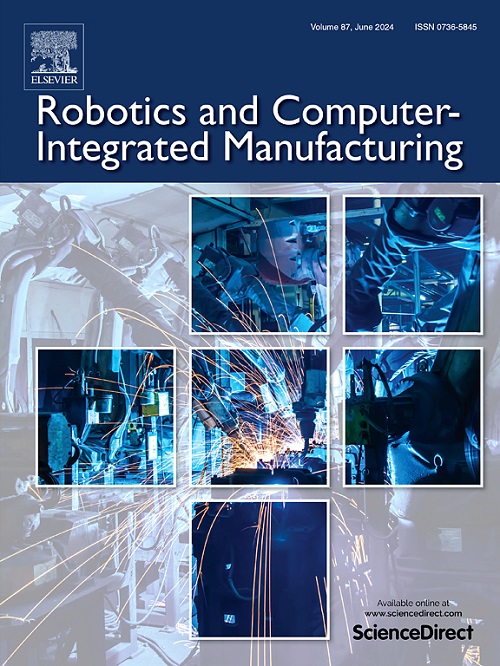由大型语言模型驱动的数控系统五维数字孪生框架-增强RL
IF 11.4
1区 计算机科学
Q1 COMPUTER SCIENCE, INTERDISCIPLINARY APPLICATIONS
引用次数: 0
摘要
为了应对计算机数控系统日益增长的智能化和数字化需求,特别是在制造业的虚拟调试、性能评估和加工质量优化方面,本研究探讨了从物理空间中的物理实体到数字孪生空间中的孪生实体的映射过程。它进一步深入研究了代表这些实体的物理机制的数据传输层。数字孪生技术通过构建多层模型,为数控系统中多层耦合单元的虚拟仿真和个性化服务提供了便利。然而,考虑到CNC系统内部单元的复杂性和多样性,传统的CNC加工系统仍然过度依赖于人类的专业知识,而现有的数字孪生框架缺乏针对CNC领域的有效表示和高效优化方法。本文提出了一种新的五维框架,用于CNC系统中的数字孪生,以应对这些挑战,该框架由大型语言模型辅助增强强化学习驱动。该框架利用了数字孪生技术在动态过程管理方面的优势,以及在智能分析和决策方面的强化学习。它包括五个关键层:物理实体层、虚拟实体层、智能决策层、数据传输层和实时计算层。它还涵盖了多领域建模,包括信息模型、机制模型和数字线程,并探讨了大型语言模型(LLM)如何帮助和增强CNC应用中的强化学习。最后,该研究将该框架应用于CNC系统中的刀具轴矢量规划问题,将LLM定位为强化学习中的间接决策者。实验结果表明,将llm增强的强化学习算法集成到数控系统的数字孪生框架中,可以有效地降低刀具轴矢量变化率,从而减少加工过程中的碰撞干扰事件。在一定程度上,所提出的数字孪生框架的有效性得到了验证,为CNC系统领域的发展提供了一条有价值的途径。本文章由计算机程序翻译,如有差异,请以英文原文为准。
A five-dimensional digital twin framework driven by large language models-enhanced RL for CNC systems
In response to the growing demand for intelligence and digitalization in computer numerical control (CNC) systems, particularly in virtual debugging, performance evaluation, and machining quality optimization within the manufacturing sector, this study explores the mapping process from physical entities in the physical space to twin entities in the digital twin space. It further delves into the data transmission layer that represents the physical mechanisms of these entities. By constructing multi-layered models, digital twin technology facilitates the virtual simulation and personalized services of multi-layer coupled units in CNC systems. However, given the complexity and diversity of internal units in CNC systems, traditional CNC machining systems remain overly reliant on human expertise, while existing digital twin frameworks lack effective representation and efficient optimization methods tailored to the CNC field. This paper proposes a novel five-dimensional framework for digital twins in CNC systems to address these challenges, driven by large language models-assisted enhanced reinforcement learning. The framework leverages the advantages of digital twin technology in dynamic process management and reinforcement learning in intelligent analysis and decision-making. It comprises five key layers: the physical entity layer, the virtual entity layer, the intelligent decision-making layer, the data transmission layer, and the real-time computation layer. It also encompasses multi-domain modeling, including information models, mechanism models, and digital threads, and explores how large language models (LLM) can assist and enhance reinforcement learning in CNC applications. Finally, the study applies the framework to the tool-axis vector planning problem in CNC systems, positioning the LLM as an indirect decision-maker within reinforcement learning. Experimental results demonstrate that integrating LLM-enhanced reinforcement learning algorithms within the CNC system’s digital twin framework effectively reduces tool-axis vector variation rates, thereby decreasing collision interference incidents during machining. To some extent, the proposed digital twin framework’s effectiveness has been validated, providing a valuable approach for the advancement of the CNC system field.
求助全文
通过发布文献求助,成功后即可免费获取论文全文。
去求助
来源期刊
CiteScore
24.10
自引率
13.50%
发文量
160
审稿时长
50 days
期刊介绍:
The journal, Robotics and Computer-Integrated Manufacturing, focuses on sharing research applications that contribute to the development of new or enhanced robotics, manufacturing technologies, and innovative manufacturing strategies that are relevant to industry. Papers that combine theory and experimental validation are preferred, while review papers on current robotics and manufacturing issues are also considered. However, papers on traditional machining processes, modeling and simulation, supply chain management, and resource optimization are generally not within the scope of the journal, as there are more appropriate journals for these topics. Similarly, papers that are overly theoretical or mathematical will be directed to other suitable journals. The journal welcomes original papers in areas such as industrial robotics, human-robot collaboration in manufacturing, cloud-based manufacturing, cyber-physical production systems, big data analytics in manufacturing, smart mechatronics, machine learning, adaptive and sustainable manufacturing, and other fields involving unique manufacturing technologies.

 求助内容:
求助内容: 应助结果提醒方式:
应助结果提醒方式:


